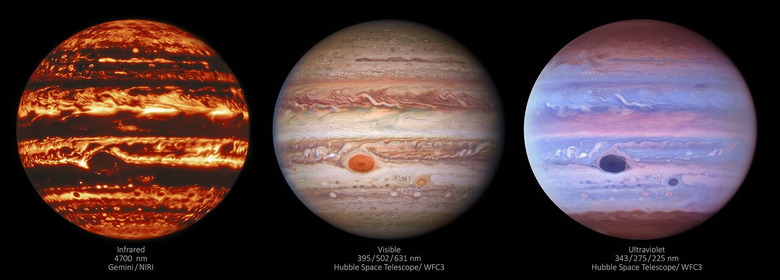Jupiter's Atmosphere Imaged Using Different Colors Of Light
New images have been shared of Jupiter taken in multiple colors of light. The images come from Gemini North and the NASA/ESA Hubble Space Telescope and showcase Jupiter in infrared, visible, and ultraviolet wavelengths of light. The images show atmospheric features of Jupiter including the Great Red Spot, superstorms, and massive cyclones that stretch across the disc of the planet.
Visible and ultraviolet views of the planet were captured using the Wide Field Camera 3 on the Hubble Space Telescope. The infrared image was taken using the Near-InfraRed Imager instrument at Gemini North in Hawaii. The trio of observations was taken at the same time, January 11, 2017, at 15:41 universal time.
Astronomers note the three images highlight a key advantage of multi-wavelength astronomy by allowing scientists to gain otherwise unavailable insights into the planet by viewing Jupiter in different wavelengths of light. Jupiter has a vastly different appearance in infrared, visible, and ultraviolet observations.
One interesting aspect to note is that the Great Red Spot, which is a massive storm on Jupiter, is plainly visible in both visible and ultraviolet images, but is almost invisible in infrared. The Great Red Spot is large enough to fit our entire planet inside. The images also show other storm systems visible on the surface of the massive planet. Another region nicknamed Red Spot Jr. is in the bottom right section of the planet not too far from its massive sibling.

That smaller storm formed in 2000 when three similar-sized storms merged. Another notable object in the atmosphere is a bright streak in the northern hemisphere of the planet. That streak is a cyclonic vortex or possibly a series of vortices and extends nearly 45,000 miles in the East-West direction.
